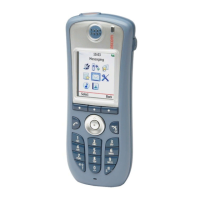TD 92685EN
28 June 2012 / Ver. A
Troubleshooting Guide
Ascom i62 VoWiFi Handset
10
3. The VoWiFi Handset as
3. The VoWiFi Handset as a Wireless Client
A handset is designed to be a part of a VoWiFi system that enables voice communication
across RF channels. RF channels are provided by Access Points (APs) connected to a wired
LAN. Before a handset can access the network, it must have been authenticated by the AP
to verify that it is allowed to connect to the network. If the verification is successful, the
handset forms an association with the AP and communications may begin.
A Basic Service Set (BSS) is an AP an
d the clients that are in communications range of that
AP. A client, or handset, in the context of a WLAN becomes a member of the BSS when it
becomes associated with the AP. In the usual implementation of a permanent, or
infrastructure, WLAN, a BSS can only have one AP. The MAC address of the AP is used to
uniquely identity the BSS and thereby provide the BSS identity (BSSID).
The BSSID of the AP that the handset is associated with can be read from the handset
display as described in section 5.2.1 Show RSSI on page 33.
The name of a WLAN to which devices connect to is specified by a Service Set Identifier
(SSID). All wireless devices connected to a WLAN must employ the same SSID to
communicate with each other. The SSID is set on the AP and broadcast to all wireless devices
in range. The SSID that a handset is connected to can be read from the handset display as
described in section 5.2.1 Show RSSI on page 33.
3.1 VoWiFi Handset Protocol Layers
The handset uses protocols defined in a 4 layer TCP/IP protocol stack, which has similarities
to some of the layers defined in the Open Systems Interconnection (OSI) 7 layer protocol
model. A thorough understanding of the protocols at each level is essential to
understanding how data is moved across a network. A support engineer with a good
understanding of the media and the data structures and devices involved at each level of
the protocol will have a systematic view of where problems may be occurring and a
methodological approach to solving them. In addition, he or she will have a considerable
armory of tools and utilities at hand for investigating sources of trouble.
The TCP/IP protocol stack is all about data com
munication across a WLAN and the use of
protocols such as:
• Application layer for applications that interfa
ce with the transport layer, including PBX,
Unite, Dynamic Host Name Configuration Protocol (DHCP) and Domain Name Server
(DNS).
• Transmission Control Protocol (TCP). Transports
User Datagram Protocol (UDP) and TCP
packets. TCP ensures secure and correct delivery of TCP packets through retransmission
of lost packets, congestion throttling and error free transmission.
• Internet Protocol (IP) assigns each networked device its logi
cal IP address
• Link layer consisting od
MAC and physical sub layers specified in 802.11 for defining the
physical characteristics of the carrier medium and access protocols.
The role of the handset in moving data across th
e network between different physical and
logical entities defined by the protocols is summarized below:
Layer Entity sending or
receiving info
Function
Application layer Application data packets There are mainly two
ser
vices that are integrated
in the handset:
- VoIP using either the SIP
or H.323 standar
d
- Unite communication
su
ite

